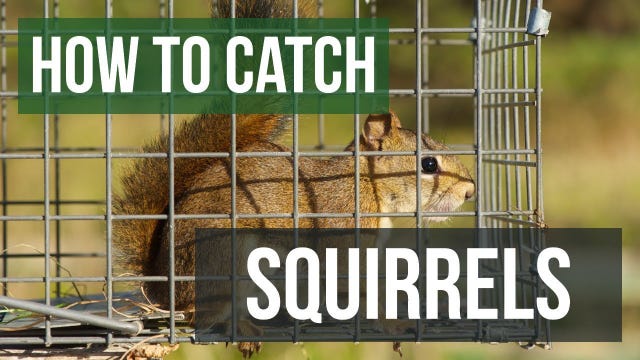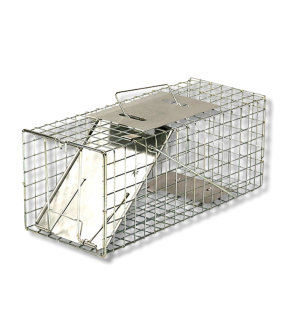Gain access to personalized product screening, the best pricing, rewards, and more!
Most Effective Products
How to Catch a Squirrel with a Live Trap
Squirrels are often depicted as cute animals burying acorns and having chubby cheeks. However, these creatures can cause severe damage, like chewing on electrical wiring and gnawing holes in your walls. One method of removing a squirrel from your property is using a live trap to catch and release the animal. Live trapping is a safe and effective way to keep animals away from your home.
If you want to catch a squirrel with a live trap, read this guide for instructions and product recommendations.
Identification
Before using a live trap, you must ensure that the wild animal you are dealing with is a squirrel. This will ensure that you are using the correct bait and strategies.
Squirrels are generally between 8 and 20 inches long and weigh no more than 2 pounds. They have a bushy tail. These animals are quite chatty and will make noises similar to barks and purrs to communicate with one another. Squirrels are active during the daytime and are excellent climbers.
Use the image and description above to confirm that you are dealing with a squirrel on your property.
Inspection
Once you've confirmed that your pest animal is a squirrel, it is helpful to recognize the areas where it is most active. This is where you will place your live trap.
Where to Inspect
You want to pick areas that have high activity from squirrels. These animals are most likely searching your property for food. Birdfeeders, as well as any vegetation, will most likely be spots where squirrels are most active. You will also want to check in trees for hollowed areas or nests. Squirrels will typically look for tree nuts, fruits, and berries. If you have gardens, check that area as well.
What to Look For
Fruit and vegetable gardens will have gnaw marks or eaten food if there is squirrel activity. You may also notice nests in trees. If squirrels are in your attic, you may hear thumping in the daytime or notice damaged shingles and voids in your attic. Items with chew marks, such as wood and wiring, also show squirrel activity.
Treatment
Now that you've identified your pest animal as a squirrel and noted areas where it is most active, you can use your live trap. Be sure to wear gloves when handling the trap to prevent leaving your scent. If a squirrel picks up a human scent on the trap, it will avoid it, making it ineffective.
Step 1: Remove Food Sources
You want the squirrel to enter the live trap with the help of bait. Because of this, competing food sources need to be removed. Keep your trash sealed in trash bags and stored in trash bins with a lid to keep it closed. Any pet food or water bowls should be placed inside as soon as possible. Clean bird feeders to make sure there isn't excess birdseed scattered around.
Step 2: Place the Trap
By now, you should have taken note of areas with high squirrel activity. These areas are where you will put your trap. Be sure to place your trap on an even surface. A squirrel might push or knock over the trap to reach the bait inside. Place a brick or weight on top of the trap to avoid this.
Step 3: Bait and Set the Trap
Using the proper bait will increase your chances of catching a squirrel. These animals prefer peanut butter, nuts, or fruits like apples. The bait should be placed near the back of the trap. This ensures the squirrel must step on the trigger plate to reach the food.
You will then set your trap by pushing on the door lock and lifting the door plate. Keep the door plate lifted while pulling the trigger arm forward to set it. You will know it is set when the trigger arm's hook catches the door.
Step 4: Monitor the Trap
You will need to check the traps twice a day, preferably once in the morning and once in the evening. This is when you will refill bait if needed. Checking the trap frequently may dissuade squirrels from approaching the trap. Do not keep an animal trapped in the cage for 24 hours.
Step 5: Relocate the Squirrel
Any non-target animals should be released immediately. Once you have captured a squirrel in your live trap, check with your local authorities to ensure you correctly relocate the animal. Approaching the trap slowly, use a gentle voice. Place a towel over the cage to avoid frightening the squirrel. Once you have relocated far enough, carefully open the trap and release the animal. You can read more about releasing an animal from a live trap here.
Prevention
After using your live trap, you want to ensure that wild animals do not invade your property again. You can take some preventative measures to keep your area free of squirrels.
Sanitation
Keeping trash out is an open invitation for a squirrel. Be sure to place all waste in a trash can, preferably with a lid to keep it closed. Remove all clutter and debris from your property since squirrels may be drawn to use these materials for nests. Any potential food sources, especially bird seed, should be properly stored.
Exclusion
To prevent squirrels from entering your home, check the foundation for cracks and crevices. These can be sealed with Stuf-Fit Copper Mesh and caulk. Stuf-Fit is a breathable material that many animals cannot chew through. It will not rust and can be stuffed into cracks and crevices before sealing with caulk. Repair any voids or openings around the home or structure, such as damaged roof shingles.
Key Takeaways
- Squirrels are active during the daytime. They have bushy tails and are excellent climbers. Squirrels nest in trees but may enter your attic looking for shelter. They can become dangerous by chewing through wiring or gnawing on foundation structures.
- Bait the live trap with peanut butter or cereal, placing it behind the trigger plate.
- Check the trap once in the morning and once in the evening. Once a squirrel is caught, check with your local authorities to ensure you safely and correctly release it.
- Remove potential food sources and trash and seal cracks and crevices with Stuf-Fit Copper Mesh and caulk to prevent squirrels from entering your property again.








